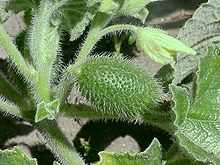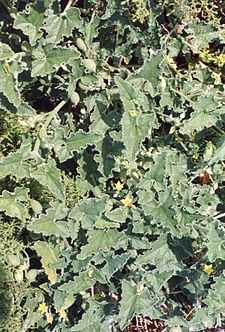Ecballium elaterium
| Squirting Cucumber | |
|---|---|
 | |
| A fruit of the squirting cucumber | |
| Scientific classification | |
| Kingdom: | Plantae |
| (unranked): | Angiosperms |
| (unranked): | Eudicots |
| (unranked): | Rosids |
| Order: | Cucurbitales |
| Family: | Cucurbitaceae |
| Subfamily: | Cucurbitoideae |
| Tribe: | Benincaseae |
| Subtribe: | Benincasinae |
| Genus: | Ecballium A.Rich. |
| Species: | E. elaterium |
| Binomial name | |
| Ecballium elaterium (L.) A.Rich. | |
| Synonyms | |
|
Elaterium Mill. | |
Ecballium elaterium, also called the squirting cucumber or exploding cucumber (but not to be confused with Cyclanthera explodens), is a plant in the cucumber family. It gets its unusual name from the fact that, when ripe, it squirts a stream of mucilaginous liquid containing its seeds, which can be seen with the naked eye. It is thus considered to have rapid plant movement.
It is native to Europe, northern Africa, and temperate areas of Asia.[1] It is grown as an ornamental plant elsewhere, and in some places it has naturalized.[1][2]
It is suspected to provide food for the caterpillars of the tortrix moth Phtheochroa rugosana.
This plant, and especially its fruit, is poisonous, containing cucurbitacins. In the ancient world it was considered to be an abortifacient.
In Turkey, the fresh fruit juice of this plant is directly applied into the nostrils for the treatment of sinusitis as an herbal medicine. Clinical tests on voluntary patients revealed that the healing rate of double-high dosage application is higher than that of the single-low dosage (71.0 and 56.6%, respectively). In addition, total relief from the main symptoms is observed in 20% of the patients, although the sinuses are not completely drained off on x-ray examination.[3]

References
| Wikimedia Commons has media related to Ecballium elaterium. |
- ↑ 1.0 1.1 "Ecballium elaterium (L.) A. Rich.". Germplasm Resources Information Network.
- ↑ "Ecballium elaterium (L.) A. Rich.". USDA PLANTS.
- ↑ Sezik, E. (1997). "Research on the Turkish Medicinal Plant Ecballium elaterium". Chemistry of Natural Compounds 33 (5): 541–542. doi:10.1007/BF02254799.